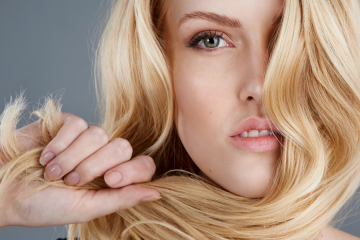Whether it's seasonal or gradual, partial or total, hair loss is often a painful experience for those who suffer from it. However, it's important to know that, apart from the need for medical treatment, hair loss is completely normal: we all lose between 50 and 100 hairs a day, and some even more, depending on hair type, age, season and heredity.
Pollution, stress and dietary imbalances are just some of the reasons why more and more people, and younger and younger, are suffering from hair loss. Long spared, at least until the menopause, women are now also affected by this phenomenon.
What you need to know about hair loss
- Hair grows by 1 mm every 3 days, which corresponds to around 12 to 15 cm per year. Growth phases last from 3 to 6 years. The resting phase lasts 3 weeks. During this period, the hair dies, followed by a 3-month fall phase.
- The life and death of hair
The scalp is covered with hair follicles. Each one lives independently, at its own pace.

Follicles in the anagen phase (growing), catagen phase (regressing) or telogen phase (during which the hair will detach from the bulb) therefore coexist on our head.
After the telogen phase, there is a latent phase before the reservoir of stem cells in the scalp gives rise to a new bulb.
- male specificity
In men, the hair on the crown never falls out. It's thought that these hairs are different from those on the top of the head. In particular, they are not as sensitive to testosterone. That's why they're the ones we reimplant during a hair transplant, because once they've been grafted onto another part of the scalp, they retain their immortality.

To find out more...
Types of hair loss
There are two main types of hair loss:
- Temporary hair loss or effluvium. Its appearance is punctuated by life's events: childbirth, menopause, change of season, extreme fatigue, strict diet, emotional shock, depression, medication, surgery...
- Persistent hair loss or androgenetic alopecia. It primarily affects men, but also 15-20% of women, and 30-40% at menopause.
Androgenic alopecia

Hair loss has a strong hereditary component. The risk of going bald is all the higher if one of your ancestors is bald. Some twenty different genes are associated with baldness.
In over 90% of men, hair loss is a sign of " androgenic alopecia ". Under the effect of a testosterone derivative, DHT (dihydrotestosterone), the hair follicle degenerates. Hair becomes thinner and more fragile.
The cycles get shorter and shorter, and by the end, the hair follicle is producing only a tiny amount of down.
By the age of 20, 20% of men are affected. From the age of 50 onwards, one man in two suffers from androgenic alopecia.
Advice from Christophe Nicolas Biot
- A well-balanced diet and a healthy lifestyle have a direct impact on metabolism.
- Hair loss is an internal problem. Our hair reflects what's going on inside our bodies: fatigue, stress, medication.....
- The solutions I recommend are tooxygenate the scalp, relax it, take care of it, and of course choose the right products and eat a healthy diet.
- I'm not in favor of surface solutions, I'm in favor of in-depth solutions. This means it will take time, but it's the only lasting solution. For a treatment to take effect, you need a 12-month cycle. Taking capsules is useless if you don't pay attention to your diet and the products you use.
- You have to take care of your hair all the time and not wait until there's a problem to react.
- Any good hairdresser knows whether it's temporary hair loss or a medical problem. Both incipient baldness and temporary hair loss can be treated.






